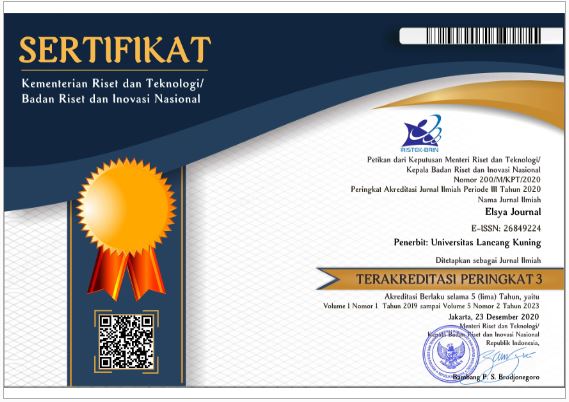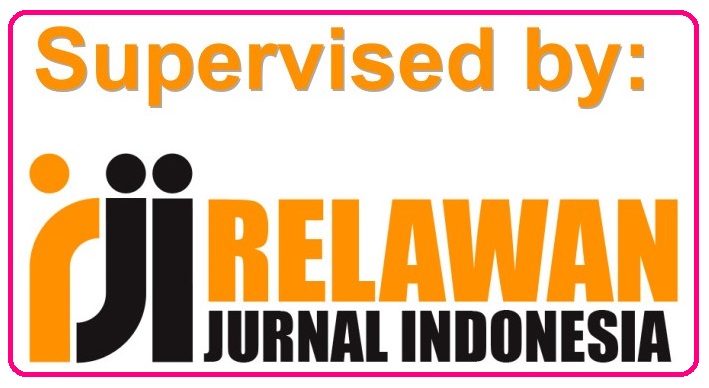How First and Second Languages Influence Indonesian Students’ English as a Third Language: Transfer and Interference Analysis
Abstract
In the face of the scarcity of linguistic studies on Batak Toba language, this study tries to contribute by investigating how Batak Toba students’ local language and mother tongue’s elements are transferred to their English as a foreign language output. Specifically, this study aims to describe the transfer and interference of Batak Toba and Indonesian as first and/or second language and how they influence learners’ English as a third language. The study observed 15 English Education programme students who were selected via snowball sampling and analysed the way the students speak and translate a set of phrases to their respective second and third languages. Results indicated that the students’ first and second languages interferes with their English language performance at the phonological, morphological, and syntactic levels. The novelty of this study is that it offers a detailed investigation of how students whose first language, Batak Toba, and second language, Indonesian, interfere with the foreign language that is a mandatory subject in the country’s formal education system, namely English. Recommendations for teachers, particularly teachers of Indonesian learners whose students are primarily bilingual and multilingual, are discussed.
Downloads
References
Adnyani, K. E. K., Puspawati, N. W. N., & Suwastini, N. K. A. (2021). “Makam” nasi: Language interference of a Japanese young learner in Indonesia. Jurnal Pendidikan dan Pengajaran, 54(3). https://doi.org/10.23887/jpp.v54i3.41023
Akan, M. F., Karim, M. R., & Chowdhury, A. M. K. (2019). An analysis of Arabic-English translation: Problems and prospects. Advances in Language and Literary Studies, 10(1), 58-65. https://doi.org/10.7575/aiac.alls.v.10n.1p.58
Al-Badawi, K. (2012). An analysis of phonetic, morphological and syntactic errors in English: A case study of Saudi BA students at King Khalid University. International Journal of Social Science and Humanity, 2(6), 536.
Ali, N. A. (2007). Some linguistic problems facing Arab learners of English. Adab Al-Rafidayn, 48, 465-488.
Al-Khresheh, M. H. (2016). A review study of error analysis theory. International Journal of Humanities and Social Science Research, 2, 49-59.
Al-Rawahi, N. M., & Al-Balushi, S. M. (2015). The Effect of Reflective Science Journal Writing on Students' Self-Regulated Learning Strategies. International Journal of Environmental and Science Education, 10(3), 367-379.
Al-Zuoud, K. M., & Kabilan, M. K. (2013). Investigating Jordanian EFL Students' spelling errors at tertiary level. International Journal of Linguistics, 5(3), 164.
Aoun, J. E., Benmamoun, E., & Choueiri, L. (2009). The syntax of Arabic. Cambridge University Press.
Augoustinos, M. (2022). Concluding Remarks: The Future of Multiculturalism?. In The Far-Right Discourse of Multiculturalism in Intergroup Interactions (pp. 241-256). Palgrave Macmillan, Cham. https://doi.org/10.1007/978-3-030-89066-7_10
Azanella, L. A., Tamtomo, A. B., & Velarosdela, R. N. (2019, March 30). Cek Fakta Jokowi Sebut ada 714 Suku dan 1001 Bahasa di Indonesia. Kompas.com. https://nasional.kompas.com/read/2019/03/30/21441421/cek-fakta-jokowi-sebut-ada-714-suku-dan-1001-bahasa-di-indonesia
Bahr, R. H., Silliman, E. R., Danzak, R. L., & Wilkinson, L. C. (2015). Bilingual spelling patterns in middle school: It is more than transfer. International Journal of Bilingual Education and Bilingualism, 18(1), 73-91. https://doi.org/10.1080/13670050.2013.878304
Batubara, F., Derin, T., Putri, N. S., & Yudar, R. S. (2020). Five factors influencing the students’ motivation to learn English as a foreign language: a closer look into montessori classroom environment. REiLA: Journal of Research and Innovation in Language, 2(2), 76-84. https://doi.org/10.31849/reila.v2i2.3165
Bennui, P. (2016). A study of L1 intereference in the writing of Thai EFL students. Malaysian Journal of ELT Research, 4(1), 31.
Chung, S. C., Chen, X., & Geva, E. (2019). Deconstructing and reconstructing cross-language transfer in bilingual reading development: An interactive framework. Journal of Neurolinguistics, 50, 149-161. https://doi.org/10.1016/j.jneuroling.2018.01.003
Claudia, A. (2018). Perancangan Buku Visual Adat Istiadat Suku Batak Toba sebagai Bentuk Pelestarian Budaya [Doctoral dissertation, Institut Teknologi Sepuluh Nopember]. Institut Teknologi Sepuluh Nopember Research Repository. https://repository.its.ac.id/59266/
Cummins, J. (1981). The role of primary language development in promoting educational success for language minority students. In California State Department of Education (Ed.). Schooling and language minority students: A theoretical framework (pp. 3–49). Los Angeles, CA: National Dissemination and Assessment Center.
Deng, F., & Zou, Q. (2016). A study on whether the adults' second language acquisition is easy or not-from the perspective of children's native language acquisition. Theory and Practice in Language Studies, 6(4), 776. http://dx.doi.org/10.17507/tpls.0604.15
Derakhshan, A., & Karimi, E. (2015). The interference of first language and second language acquisition. Theory and Practice in language studies, 5(10), 2112. http://dx.doi.org/10.17507/tpls.0510.19
Farghal, M., & Bazzi, H. (2017). Translation of English fiction titles into Arabic. Translation & Interpreting, The, 9(2), 114-137.
Fisher, L., Evans, M., Forbes, K., Gayton, A., & Liu, Y. (2020). Participative multilingual identity construction in the languages classroom: A multi-theoretical conceptualisation. International Journal of Multilingualism, 17(4), 448-466. https://doi.org/10.1080/14790718.2018.1524896
Gao, H. (2013). On source language interference in interpretation. Theory and Practice in Language Studies, 3(7), 1194.
Geva, E., & Clifton, S. (1994). The development of first and second language reading skills in early French Immersion. The Canadian Modern Language Review, 50(4), 646–667.
Ginting, R., Lubis, B., & Sinaga, D. (2021). The Revitalization of Tugu Silalahi Batak Toba Folklore into Teaching Materials in English Subject for Junior High School. Linguistic, English Education and Art (LEEA) Journal, 4(2), 240-248. https://doi.org/10.31539/leea.v4i2.1840
Ginting, S. D. B., Lubis, B. N. A., & Sari, N. P. (2019). Revitalisasi Legenda Suku Karo “Pancur Kuta” Sebagai Bahan Ajar Kesusasteraan di Prodi Pendidikan Bahasa dan Sastra Indonesia Universitas Prima Indonesia. Kode: Jurnal Bahasa, 8(3). https://doi.org/10.24114/kjb.v8i3.14728
Grami, G. M. A., & Alzughaibi, M. G. (2012). L1 Transfer among Arab ESL Learners: Theoretical Framework and Practical Implications for ESL Teaching. Theory & Practice in Language Studies, 2(8). https://doi.org/10.4304/tpls.2.8.1552-1560
Iswandi, F. D. (2021). An Analysis Of Code Mixing Used In Nessie Judge Youtube Video [Doctoral dissertation, Universitas Islam Riau]. Universitas Islam Riau Research Repository. https://repository.uir.ac.id/7321/
Jabbari, A. A., & Samavarchi, L. (2011). Persian learners' syllabification of English consonant clusters. International Journal of English Linguistics, 1(1), 236.
Koda, K. (2008). Impacts of prior literacy experience on second-language learning to read. In K. Koda, & A. M. Zehler (Eds.). Learning to read across languages: Crosslinguistic relationships in first- and second-language literacy development (pp. 68–96). Mahwah, NJ: Routledge.
Lado, R. (1964). Language teaching: A scientific approach. New York: McGraw-Hill.
Liu, M., & Ni, H. (2015). Chinese University EFL Learners' Foreign Language Writing Anxiety: Pattern, Effect and Causes. English Language Teaching, 8(3), 46-58.
Lubis, B. N. A., & Asnawi, A. (2021). Family’s Addressing Male and Female Batak Toba Tribe in Indonesia . Randwick International of Education and Linguistics Science Journal, 2(2), 228-232. https://doi.org/10.47175/rielsj.v2i2.253
Manyasa, J. (2021). When Language Transfer is Negative: Analysis of Morpho-Syntactic Interference Errors by Learners of French in Tanzanian Higher Learning Institutions. Journal for Foreign Languages, 13(1), 165-190. https://doi.org/10.4312/vestnik.13.165-190
Marwa, M. (2014). Reasons for Students’ Code-Switching Between Informal Indonesian and English in ELT Contexts. ELT-Lectura, 1(1). https://doi.org/10.31849/elt-lectura.v1i1.446
Mukminin, A., Masbirorotni, M., Noprival, N., Sutarno, S., Arif, N., & Maimunah, M. (2015). EFL speaking anxiety among senior high school students and policy recommendations. Journal of Education and Learning, 9(3), 217-225.
Nabokov, V. (2021). Problems of translation: Onegin in English. In The translation studies reader (pp. 143-155). Routledge.
Novelita, R., Luthfie, M., & Fitriah, M. (2019). Komunikasi Budaya Melalui Prosesi Perkawinan Adat Pada Suku Batak Toba. Jurnal Komunikatio, 5(2). https://doi.org/10.30997/jk.v5i2.1752
Poudel, S. (2019). Code-Mixing and literal translation in Nepal’s English newspapers. Journal of NELTA, 24(1-2), 191-203. https://doi.org/10.3126/nelta.v24i1-2.27692
Purandina, I. P. Y., Sutrisna, G., & Sudarmawan, I. P. Y. (2021). An Analysis of Students’ Perception on Code Mixing Used in ELT: A Case Study at Dwijendra Primary & Secondary School. Widya Accarya, 12(2), 268-275. https://doi.org/10.46650/wa.12.2.1134.268-275
Rahayu, A. C. (2012). Teori Transfer Dan Teori Interferensi Dalam Pemerolehan Bahasa Kedua Atau Bahasa Target. PARAFRASE: Jurnal Kajian Kebahasaan & Kesastraan, 12(01). https://doi.org/10.30996/parafrase.v12i01.210
Ritonga, M. G. S., Lubis, B. N. A., Simamora, W. R., & Situmorang, R. (2021). The Revitalization of Patung Sigale-Gale Batak Toba Folklore into Teaching Material in English Subject for Junior High School. English Teaching and Linguistics Journal (ETLiJ), 2(1), 89-97. http://dx.doi.org/10.30596%2Fetlij.v2i1.5776
Rofii, A., & Hasibuan, R. R. (2019). Interferensi bahasa batak mandailing dalam tuturan berbahasa indonesia pada acara parpunguan masyarakat mandailing kota jambi. Aksara: Jurnal Ilmiah Pendidikan Bahasa dan Sastra Indonesia, 3(1), 16-24.
Sabbah, S. (2015). Negative transfer: Arabic language interference to learning English. Arab World English Journal (AWEJ) Special Issue on Translation, (4), 1-20. https://dx.doi.org/10.2139/ssrn.2844015
Salim, J. A. (2013). A contrastive study of English-Arabic noun morphology. International Journal of English Linguistics, 3(3), 122.
Saragih, D. Y. (2021). An Analysis of Metaphor in Batak Toba Song Lyrics (Mother Love’s Theme). Budapest International Research and Critics Institute-Journal (BIRCI-Journal), 4(2), 2013-2021. https://doi.org/10.33258/birci.v4i2.1889
Sedina, I. V., & Wan, Q. (2018). The significance of literal and free translation in english movie title transaltion to chinese and russian languages. Дневник науки, (3), 14-14.
Shi, H. (2017). Learning strategies and classification in education. Institute for Learning Styles Journal, 1(1), 24-36.
Siahaan, B. (2015). Warisan Leluhur Yang Terancam Punah.
Sihombing, D. L., Lubis, B. N. A., Simbolon, A., & Simamora, F. P. (2021). The Revitalization of “Aek Sipitu Dai” Batak Toba Folklore into Teaching Materials in English Subject for Junior High School. English Teaching and Linguistics Journal (ETLiJ), 2(1), 112-121. http://dx.doi.org/10.30596%2Fetlij.v2i1.5777
Simanjuntak, M. B. (2021). METAMORPHIC ANALYSIS IN SONG LYRICS BATAK TOBA “AUT BOI NIAN” WRITTEN BY WERVIN PANGGABEAN. JOURNAL OF ADVANCED ENGLISH STUDIES, 4(1), 34-39. http://dx.doi.org/10.47354/jaes.v4i1.99
Simanjuntak, M. B., Suseno, M., Ramdhoni, R., Mayuni, I., Zuriyati, Z., & Sutrisno, S. (2022). The Value of Parents' Image in Seven Batak Toba Songs (Literary Art Study). Jurnal Pendidikan Tambusai, 6(2), 8540-8551.
Sinamo, F. L., Lubis, B. N. A., Barus, T. A. E., & Sembiring, S. J. (2021). The Revitalization of Batu Parsidangan Batak Toba Folklore Into Teaching Materials in English Subject for Junior High School. Linguistic, English Education and Art (LEEA) Journal, 4(2), 233-239. https://doi.org/10.31539/leea.v4i2.1824
Wrembel, M. (2015). Cross-linguistic influence in second vs. third language acquisition of phonology. U. Gut, R. Fuchs, & EM. Wunder (Eds.) Universal or diverse paths to English phonology, 41-70. https://doi.org/10.1515/9783110346084
- Author retains the copyright and grants Elsya Journal the right of first publication of the work simultaneously licensed under the Creative Commons Attribution-ShareAlike 4.0 License that allows others to share the work with an acknowledgment of the work's authorship and initial publication in this journal
- The author is able to enter into separate, additional contractual arrangements for the non-exclusive distribution of the journal's published version of the work (e.g., post it to an institutional repository or publish it in a book) with the acknowledgment of its initial publication in this journal.
- The author is permitted and encouraged to post his/her work online (e.g., in institutional repositories or on their website) prior to and during the submission process, as it can lead to productive exchanges, as well as earlier and greater citation of the published work (See The Effect of Open Access).









 Elsya Journal is licensed under
Elsya Journal is licensed under 